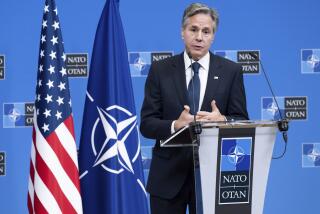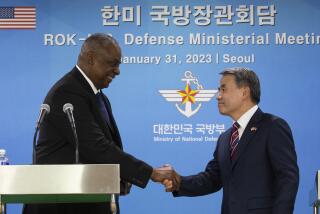U.S. Still Must Be Ready for War x 2
- Share via
For decades, the United States has sought the military means to fight and win major wars in two parts of the world at the same time. During the Cold War, the Pentagon prepared for a titanic war in Europe and a smaller war elsewhere; since then, it has planned for simultaneous conflicts against Iraq and North Korea.
Many suspect that Defense Secretary Donald Rumsfeld, who is scheduled to testify on this issue today before Congress, will abandon this time-honored approach to sizing American combat forces. But that is unlikely.
As Rumsfeld surely realizes, a superpower with about 60 treaty allies and close security partners on six continents should have the wherewithal to handle more than one conflict at a time. The ability to do so also strengthens deterrence and reduces the odds that simultaneous conflicts will erupt.
However, today’s two-war framework, with its excessive focus on Iraq and North Korea, does need revamping. Under current thinking, whether conflict occurs on the Arabian desert or the hilly, forested Korean peninsula, the Pentagon would plan on sending almost the same package of forces that won Desert Storm 10 years ago--about half a million troops in either case. This approach is not only illogical, it is too expensive at a time when new defense needs cry out for funding and when President Bush’s tax cut is limiting the available federal reserves.
Moreover, events of the last decade have reduced the threats posed by Iraq and North Korea, greatly lessening the odds that either even could win the initial battles in a future war. In Iraq, for example, the military has remained at about half its pre-Desert Storm strength. In North Korea, the armed forces have suffered from a decade of national economic decline.
Meanwhile, allied capabilities have improved. South Korea’s underrated forces have continued to modernize and still maintain a thicker forward defense along the DMZ than NATO fielded in Germany during the Cold War. The U.S. military is much more adept at precision attack than it was at the time of Desert Storm. And, by stationing more equipment overseas and purchasing advanced transport ships, it has also improved its capacity for rapid deployment.
Given these trends, it is simply unbelievable that the U.S. and its allies would lose the initial battles against both Iraq and North Korea and then require reinforcements from half a million GI’s to liberate allied territory and win either war. Leaders in Baghdad and Pyongyang probably recognize this, and so deterrence is unlikely to fail--at least in these two cases.
If today’s two-war framework is excessive in some ways, however, it pays insufficient heed to other challenges. High on the list is a possible China-Taiwan war. Taiwan probably would not need U.S. help to repulse a Chinese invasion but could require assistance to break a naval blockade. Such a conflict would place less emphasis on ground forces and more on aircraft carriers, submarines and other naval assets.
Fortunately, if somewhat serendipitously, the Defense Department appears to have the requisite numbers of forces to handle such a Taiwan crisis. But it may need specialized capabilities that it does not have today. For example, the Pentagon may need to put more effort into protecting and backing up its satellites, since China may soon be able to attack them.
Change should not, however, go too far. As long as the Iraqi and North Korean threats remain, prudence dictates that the country should have a robust capability.
As another example of the possible need for ground forces, suppose that Pakistan began to collapse and its government needed help protecting the country’s nuclear weapons against extremist factions. Even Bush, who opposes most peacekeeping missions, might have trouble watching that type of conflict from the sidelines. For these reasons, the U.S. Army must remain at least 90% as large as it is today.
Rumsfeld is right that the country’s military strategy requires change. However, some form of a two-war capability is still a must.
More to Read
Sign up for Essential California
The most important California stories and recommendations in your inbox every morning.
You may occasionally receive promotional content from the Los Angeles Times.













